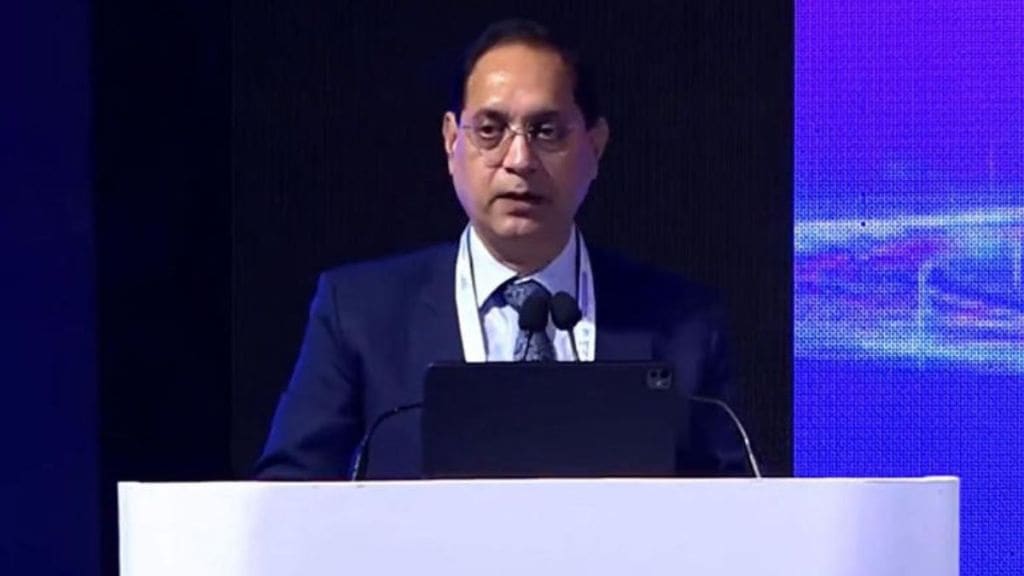The Securities and Exchange Board of India has set an ambitious target of doubling the number of investors in the Indian equity market, said Chairman Tuhin Kanta Pandey at an CII event on Monday.
Citing data from an investor survey by the market regulator, Pandey said that while 63% of the households are aware of the securities market, only about 9.5% are investing in it and another 22% are looking at investing in it over the next 12 months
He also added that the India’s domestic story is far from bubble-territory and a correction in the US markets, will have limited impact on India given the important role of retail investors as shields against such shocks.
“This is not the story of a market growing on sentiment; this is the story of an economy whose productive sectors are increasingly funded through transparent, fair and competitive market mechanisms,” Pandey said. Market-based financing reduces concentration risks, diversifies funding channels and strengthens financial stability, he said.
Indian securities market is no longer a peripheral source of financing, instead it facilitated average issuances of roughly ₹9.5 lakh crore every year in debt and equity past ten years, said Pandey. Sebi will shape a smarter rule book that is easy, risks-adjusted and pro-innovation. Improving listing processes and post-listing flexibility is important to deepen capital markets, he said.
In the current financial year, from April to October of FY26, equity capital raised has already crossed ₹2.5 trillion, while corporate bond issuances have touched almost ₹5.5 trillion in the first seven months. A decade ago, outstanding corporate bonds were 43% of bank credit compared to nearly ₹55 trillion, close to 60% now. “These numbers reflect something deeper,” he said.
India’s market capitalisation-to-GDP ratio moved from around 69% in FY16 to above 130% today, while mutual fund industry grew from ₹12 trillion in FY16 to nearly ₹80 trillion today. Rise of the AIF ecosystem, from a modest ₹0.2 trillion in FY16 to more than ₹6 trillion today, marks another shift, he said.
“Risk capital is flowing into startups, early-stage ventures and new-economy at a scale unimaginable even a decade ago. These are interconnected signs of a maturing financial system, rooted in a steady reform agenda,” he said. “One of our key priorities over the last few years has been simplifying market processes so that issuer, investor or intermediary, interacts with the market smoothly,” Pandey said.
Sebi has undertaken important steps to improve the experience of issuers, including rationalisation of Minimum Public Offer (MPO) scale-based thresholds for companies with substantial market value to achieve public float requirements. Enabling founders to retain certain ESOPs post-listing, expanding the scope of Electronic Book Provider (EBP) platforms to include REITs and InvITs are notable reforms, he said.
“We have introduced reforms that are increasingly focused on transparency in disclosures, accountability and prompt identification and mitigation of risks,” Pandey said.
SME platforms have opened new avenues for smaller enterprises to raise capital. “Enhanced scrutiny and stronger governance norms for SME issuers are designed to ensure that the platform remains credible, protects investors and fulfils its objective of nurturing growth enterprises.”
To ease the process of fund raising for IPO bound companies whose pre-IPO shares are pledged is being streamlined, Sebi is proposing a new framework which will ensure lock-in requirements get automatically enforced even if the pledge is invoked or released, thereby preventing listing delays. “We are also proposing to rationalise the existing contents of the Offer Document Summary. This summary will also be made available separately to investors from the Offer Document, to reduce their reliance on unverified social media or grey market tips,” he said.
A comprehensive review of Sebi’s regulations is underway. The process is well advanced for Stock Brokers Regulations and Mutual Fund Regulations. For Settlement and LODR Regulations, the preparatory work has started and public consultations will follow, Pandey said. “The goal is clear– a regulatory architecture that is contextual to our present and future needs, unambiguous, easier to comply with and more effective to supervise.”

